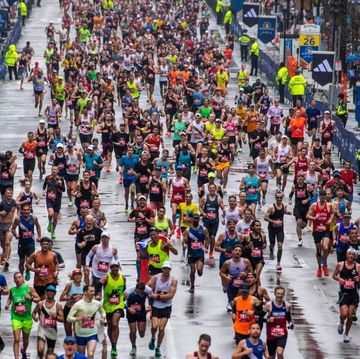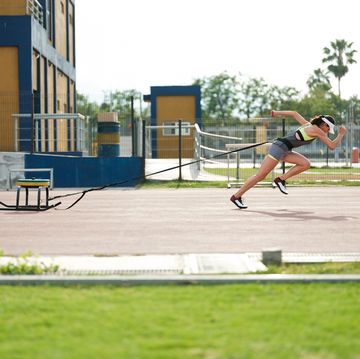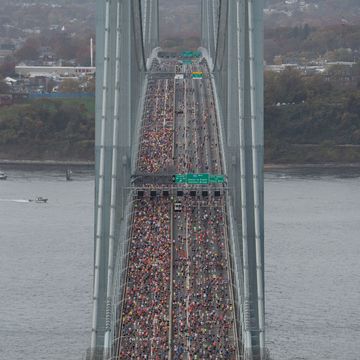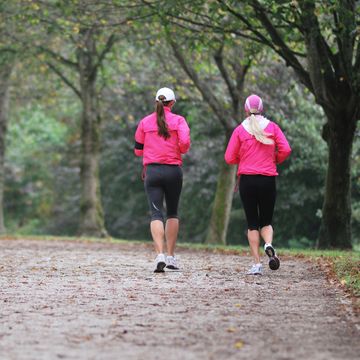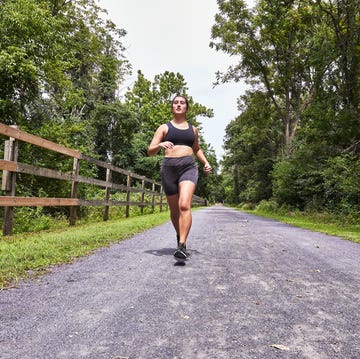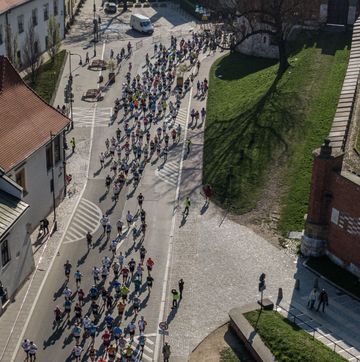One of the more exotic summer races in my hometown of Portland, Oregon, is the "Beat the Burnside." It’s an 8K, but instead of the normal finish, what you find is a drawbridge, set to be raised at a specified time. There’s no mass start; runners leave when they want, timing their departures to cut the finish as close to the bridge-raising as they dare.
But there’s another wrinkle: The point-to-point course drops 650 feet. If you’re trying to play brinksmanship games with the bridge, that raises an important question: How late can you delay your start, knowing that the hill will speed you up? And if you run a PR, what does it mean?
Downhill "PR courses" seem to be in vogue, at all distances from street miles to the marathon. Downhill marathons, in fact, are often designed to appeal to people seeking to qualify for the Boston Marathon. Under Boston’s rules, getting a gravity boost isn’t cheating; some courses, notably the St. George (Utah) Marathon and the Tucson Marathon, drop more than 2,000 feet.
At the other extreme are hill-a-thons on which it seems virtually impossible to score a personal best.
In both cases, everyone has the same question: How much do such courses affect your time? The answer may come as a surprise: Not as much as you might think.
Making the Grade
More than a quarter century ago, British researcher Mervyn Davies conducted treadmill tests that revealed that each 1 percent of upgrade slowed elite runners by about 3.3 percent. Presuming that the same percentage applies to runners of all speeds, that translates to 10 seconds per mile for 5-minute milers, 15 seconds per mile for 7:30 milers, and 20 seconds per mile for 10-minute milers. A 2 percent upgrade has twice the effect; 3 percent has three times the effect, and so on.
It’s easiest to look at this in terms of elevation change. A 1 percent grade climbs 52.8 feet per mile. Thus, in round numbers, each 100 feet of climbing is equivalent to one mile of 2 percent grade — whether it comes in a single steep pitch or spread out over several miles.
In other words, each 100 feet of climbing costs the best athletes a little less than 20 seconds. Marginal Boston qualifiers lose about 30 seconds, and 10-minute milers lose about 40 seconds.
That’s uphill. Davies also tested downgrades. Not surprisingly, he found that descents don’t give back as much as ascents take away. In fact, they only speed you up by about 55 percent as much as the corresponding upgrades slow you down.
Obviously, these numbers don’t apply to everyone. Some people simply aren’t good uphill runners. Others haven’t mastered the skills of downhill running, which involve (a) not braking; (b) not being afraid of going fast; and (c) leaning forward so that gravity pulls your torso downhill, while your legs move fast enough to keep you from falling on your face.
But these numbers do allow us to make some good estimates. Consider that 650-foot drop on the Beat the Burnside. Since we know how much each 100 feet of ascent slows you down, we can calculate the amount by which the descent speeds you up by multiplying that figure by 6.5, then taking 55 percent of the result.
For 5-minute milers, it comes up as 71.5 seconds, though there’s no reason to be that precise. A bit more than a minute will do. For 7:30 milers, it’s about 1:50. For 10-minute milers, it’s approximately 2:25.
Another popular Portland course is the Shamrock Run, a 15K that climbs a nasty 450-foot hill in its first 5K, bounces around a bit, then descends. Call it 550 feet of total climbing, with an equal amount of descent.
People think it’s a horribly slow course, but generally that’s because they go out too fast on the hill and die on the descent.
The math assumes that you pace it correctly. If you’re a 5-minute miler, the climbing should cost you 5.5 x 20 seconds, or about 1:50. The descent will give you back 55 percent of that, or about a minute. If you’re a 7:30 miler, the uphill costs 2:45 and the descent gives back 1:30. For 10-minute milers, it’s 3:40 and 2:00. Overall, therefore, the course will cost you between 50 seconds and 1:40, depending on pace.
The same math can be used as a reality check on your hill tactics during the race. On the Shamrock Run, for example, your uphill splits should reflect the expected degree of slowdown. Otherwise, you’re attacking it too hard and committing pace suicide.
Dropping Into a PR?
The Steamtown Marathon in Scranton, Pennsylvania, bills itself as America’s fastest midsized marathon.
According to its elevation profile, it has a net elevation drop of 955 feet. It also has a few bounces, which appear to total about 100 feet. In other words, there’s 1,055 feet of down, and 100 feet of up. Applying the same type of arithmetic we used for the Shamrock Run, the course should speed you up by about 1:35 at world-class pace, 2:25 at a 7:30 pace, and 3:10 at a 10-minute pace. Not huge, but definitely enough to be noticeable.
In the western U.S., there are lots of marathons with similar drops. The Las Vegas International Marathon, for example, used to be a point-to-point route with a net descent comparable to Steamtown’s. But the course has been redesigned and is now a loop with no net elevation change.
But the West has big hills, enabling courses with truly colossal drops. One is the Tucson Marathon, which starts at an elevation of 4,730 feet and, with only minor upgrades, descends approximately 2,150 feet. Another contender for fastest course in the West is the St. George Marathon, which drops 2,560 feet. But the steepest (and potentially fastest) of all is the now-defunct Pines to Palms Marathon in California, which virtually falls off a cliff with a total elevation loss of 4,920 feet.
In theory, descents that large should speed you up by four to eight minutes — a truly enormous assist. For Tucson, the gravity boost is almost precisely 4 minutes for 5-minute milers, 6 minutes for 7:30 milers, and 8 minutes for 10-minute milers. At St. George, it’s roughly comparable because, while that marathon has 400 more feet of downgrade, it also has one significant hill.
But two other factors make it unlikely that most runners will see such large gains.
One is simply that downhill courses can be rough on the quads. People in my running club always think they’re going to run PRs at Boston (a much more gentle downgrade) and only one has ever succeeded. Even if you train for them, downhills are deceptively tiring.
But a bigger problem is the fact that the only way to design a course with a big drop is by starting high. If you’ve not taken a couple days to acclimate, Tucson’s 4,730 feet is high enough to leave you out of breath. St. George starts even higher, at 5,240 feet.
Even if you’re acclimated, those are high enough to slow you down.
Altitude physiology researcher James S. Milledge studied this, publishing his results in the Oxford Textbook of Sports Medicine. The book is hard to find, but the results are summarized by South African exercise physiologist Timothy Noakes, in his treatise-length book, Lore of Running (4th Ed., pp. 574-580).
According to Noakes, Milledge examined the effect of altitude on running performance at distances ranging from 60 meters to the marathon. He found that at an altitude of 2,500 meters (8,250 feet), marathoners were slowed down by about 8 percent.
Noakes also describes a similar study from the Journal of Applied Physiology, in which a team led by kinesiologist Francois Peronnet of the University of Montreal conducted a mathematical analysis of the effect of altitude on running. Among other things, Peronnet’s team calculated that running a marathon in Mexico City (7,400 feet) would slow you down by 7.3 percent.
Both studies also found that up to elevations of about 8,000 feet, the amount of slowdown is directly proportional to the altitude. (Higher, it increases sharply.)
This means that even an elevation as low as 1,000 feet will slow you down. Specifically, each 1,000 feet above sea level will slow you down by about one percent.
Even more than beating up the quads, this is the Achilles heel of the "fast" downhill courses. In order to get the big drop, they have to start high. Even Steamtown averages 1,000 feet above sea level. Tucson averages 3,300 feet — high enough to pretty much negate the benefit of the downgrade. St. George is worse; its average elevation is about 4,500 feet — enough to convert a 3:00 marathon into a 3:08.
This is not, of course, to denigrate such races. They offer fun, scenic courses. And if you normally race in high-altitude cities such as Denver, Albuquerque, or Salt Lake City, you indeed have a good chance at a PR. But you might do even better by bringing all of that altitude training down to a flat or slightly downhill course at sea level.
Some marathons aren’t designed to be fast. "Hard," "grueling," "mountainous," "windy," "spectacular," and "unforgiving" are but a few of the words that the Big Sur International Marathon uses to describe itself.
Needless to say, it’s hilly. There is a net 275-foot downgrade, but there are also about 950 feet of bounces along the way (with 520 feet of them coming in one 2.2-mile grunt).
Combined, the bounces and the net descent make for about 950 feet of climbing and 1,225 feet of descent. It sounds horrific, but if you run it right, it’s not as bad as it sounds.
The climbing will cost 5-minute milers about 3:10. The descents will give them back about 2:15, for a net time cost of about 55 seconds. For 7:30 milers, the net time cost is 1:20; for 10-minute milers, it's a bit under 2 minutes.
Obviously, not everyone will fare that well. One look at the elevation profile, with that big spike in the middle and three steep bumps in the final four miles, reveals that this course is a hill tactician’s dream. But it’s not really as slow as the description makes it sound. The men’s record is 2:16:39. The women’s is 2:41:34.
Running High for 5K and 10K
The effect of altitude isn’t quite as dramatic for shorter races as for longer ones. But it’s still enough that I can remember feeling inexplicably slow at elevations as low as 1,600 feet.
Milledge’s data shows approximately a 7 percent slowdown for 10K runners at 8,200 feet. For 5K runners, it’s about 6 percent. And, as with marathons, the effect appears to be linear at all altitudes below 8,200 feet. In other words, each 1,000 feet of elevation slows 10K runners down by about 0.85 percent, and 5K runners by about 0.73 percent.
That doesn’t sound like much, but it adds up. At 2,000 feet, a 40-minute 10K runner is going to be about 40 seconds slow. At 4,500 feet, anything faster than 41:30 would be a triumph.
Going Up
Every 1% upgrade slows your pace 3.3% (1/30th)
Every 100 feet of elevation gain slows you 6.6% of your average one mile pace (2% grade/mile).
Example: A race that climbs 300 feet would slow an 8-minute miler (3 x .066 x 8 x 60 seconds) = 94 seconds slower at the finish
Going Down
Every 1% downgrade speeds your pace 55% of 3.3% = 1.8%
Every 100 feet of elevation descent speeds you 3.6% of your average one mile pace (2% grade/mile).
Example: A race that descends 300 feet would speed an 8-minute miler (3 x .036 x 8 x 60 seconds) = 55 seconds faster at the finish
Running High
Every 1,000 feet of altitude above sea level slows you 1% (up to 8,000 feet, then all bets are off)
Example: A race at 3,000 feet would slow an 8-minute miler (3 x .01x 8 x 60) = 14.4 seconds per mile, or 6:20 total in the marathon.
TANSTAAFH
Several decades ago, science fiction writer Robert Heinlein coined the phrase TANSTAAFL: "There ain’t no such thing as a free lunch." Sadly, it’s the same way with running. Short races such as the Beat the Burnside indeed give you chances for gravity-assisted PRs. But as soon as the desire for big downgrades starts taking you to bigger hills, Heinlein’s lesson kicks back in. Only in this case, it might be TANSTAAFH. There ain’t no such thing as a free hill.
Richard A. Lovett is coauthor of Alberto Salazar's Guide to Road Racing and has written about exercise physiology and sports psychology for New Scientist and Psychology Today magazines. A long-time runner who describes himself as "very serious but not super-fast," he coaches Team Red Lizard, a 220-member club that likes to run hills.





